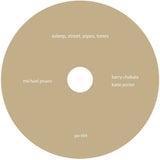Michael Pisaro/Barry Chabala/Katie Porter - asleep, street, pipes, tones (CD)
SKU:
$14.00
$12.00
$12.00
On Sale
Unavailable
per item
GW 004
CD inside a cardboard folder with liner notes info, transparent plastic cover.
|
TRACK LIST/CREDITS
1. asleep, street, pipes, tones (2009) (63'40") Michael Pisaro to phill niblock Barry Chabala-electric guitar Katie Porter-bass clarinet Brief organ samples are taken from three recordings: Eva-Maria Houben, dazwischen/immer anders (EW 0407/8) Burkhard Schlothauer, abregistrieren (EW 0501) André O. Möller, musik für orgel und eine(n) tonsetzer(in) …2003… (EW 0702), all performed by Eva-Maria Houben. thanks to Edition Wandelweiser for permission to use them. recorded and engineered by Devin Maxwell (Brooklyn, January 2011) mixed and mastered by Michael Pisaro design by Yuko Zama (released March 2, 2011) |
asleep, street, pipes, tones (2009) is an investigation of the sounding properties of pipes and streets interspersed with a duo for bass clarinet and electric guitar.
The investigations form ten three-minute episodes, assembled in studio by Pisaro from samples—mostly organ, but also tiny snippets of vocal music and a single piano chord—and field recordings. The instrumental parts, arranged in nine sections, also three minutes each, develop over the course of the 63’40” duration of the piece from a single tone into long descending melody. In most sections the samples and instruments are augmented by sine tones. REVIEWS
Brian Olewnick, Just Outside I heard this performed at Experimental Intermedia a bit over a year ago, loved it absolutely but, as with the prior work, there's only so much you can soak in on a single hearing. Yet another composition of vast depth, richness and stunning beauty. Again, looking at the score helps (thanks to Barry for sending same my way!) as there's a certain visual component--I'm not sure it's intentional but I would wager a guess so--that really adds a dimension to the listening experience. In "close constellations...", it was additive in nature; here there's some of that as well, but it also involves mirror images and a kind of poetic balance. There are 19 sections, alternating ones of tape, sine and other sounds with ones of bass clarinet (Katie Porter) and guitar (Chabala), with some overlap, each lasting 3'20". Pisaro weaves several relatively simple elements in astoundingly gorgeous fashion. One is length and complexity of phrase, beginning with four identical, whole notes separated by empty bars in the first section by the bass clarinet, followed by four notes, a step lower but identical otherwise, by the e-bowed guitar; two parallel lines. In section II, the bass clarinet walks six series of two-note steps, the guitar accompanying between portions 4 & 5, and then in unison with 6, extending a measure beyond. Looking at the score, you begin to ascertain the visual elegance in play: pared down but almost playful and certainly aware of cadence and proportion. In general, the relationships grow more complicated but a) not extremely so and b) not directly either, not only by addition. It's a properly slow progress; one has the impression that if the piece were over six hours long rather than just over one, it would indeed have become far more complex but that within that gradually growing complexity, there would always be an occasional ebbing back toward an amount of simplification, the whole pulsing and churning, but on a glacial scale. And that absolutely lovely interplay of sequencing is only one of four or five (at least) balls being juggled. Pisaro plays off other aspects of dynamics, timbre, texture and, yes, melody. The longest of these may be only four notes but, in context, they hit with full force. It's been a fascinating development (though I'm only going by recordings and the live performances I've happened to attend so I may well be getting an incomplete picture), all the severe, beautiful restrictions he'd imposed on earlier work beginning to blossom into openly lush and even (relatively) voluptuous areas. The ultra-rich organ-y electronic tones that begin filtering into the piece some 15 minutes in, not to mention the all-out pipe-organ eruptions later on are wonderful, exhilarating and, admittedly, surprising to hear. All of these, crucial as they are, are just facets of the work, however, and it's the entirety of the piece that, over many, many listens, is truly overwhelming. It manages to avoid being heard as episodic even as one's mind registers that all these scenes are transpiring. The structure somehow serves to cohere the sequences in a way I find virtually impossible to describe but can clearly comprehend--the mark of deeply true poetry. And in the end, that's this work--a profound, elusive piece of poetry, some of the richest music I've heard not only from Pisaro but anywhere, in a long, long time. Congratulations to all involved. (3/23/2011) |



